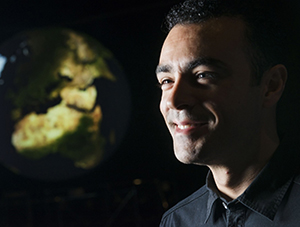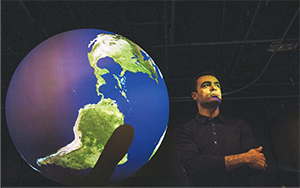News
Román Announced as New MODIS Science Team Leader for Terra and Aqua
Dr. Miguel Román has been named the team leader of the Moderate Resolution Imaging Spectroradiometer (MODIS) science team for NASA's Terra and Aqua missions. He succeeds Dr. Michael King from the University of Colorado Boulder, who recently retired after serving in this role for the past 13 years. Román also serves as the land discipline leader for the Visible Infrared Imaging Radiometer Suite (VIIRS) science team, and as senior director and chief climate scientist at Leidos, a science and technology solutions company that partners with federal agencies like NASA to address and assess climate-related risks.

"As the Terra/Aqua MODIS science team leader and Leidos' Chief Climate Scientist, I feel very fortunate to be able to serve as an integrator between the scientific community producing high quality data products that are the benchmark for Earth system science, and the stakeholders that are directly making critical decisions about the future of human settlements and life on planet Earth," Román said.
NASA's Terra and Aqua satellites, launched in 1999 and 2002, have both been flying well past their life expectancy of six years. The MODIS instrument, which flies aboard Terra and Aqua, collects imagery across a wide range of wavelengths, allowing scientists to study large-scale system dynamics driven by essential climate variables, including vegetation changes and surface albedo, sea surface temperature, cloud optical properties, snow and ice, and aerosols. Each MODIS instrument covers the entire globe twice a day.
Although Terra and Aqua are nearing their end of life, MODIS has provided more than 20 years of data, which will continue to be used by global Earth Science research and analysis programs for many years to come.
The VIIRS instrument flies aboard the Suomi National Polar-orbiting Partnership (Suomi-NPP) and NOAA-20 satellites launched in 2011 and 2017 respectively. Like MODIS, VIIRS data provides unique insights about Earth System processes and other extreme events such as wildfires, floods, heatwaves, and volcanoes.

In his new role, Román will also focus on ensuring climate data continuity by turning to VIIRS as the MODIS instruments transition into their end-of-life stage.
"We're moving from using MODIS as the gold standard for understanding the Earth’s biosphere, cryosphere, hydrosphere, and atmosphere, to using MODIS and VIIRS synergistically with other sensors as a better way to look into the future," Román said.
As one of NASA's flagship Earth Observing System (EOS) instruments, MODIS was designed to study and understand the Earth as a dynamic system with diverse subsystems that interact in complex ways.
"Now, we're transitioning from the EOS era, understanding the drivers and mechanisms of Earth’s climate system, to the Earth System Observatory era, where scientists and other stakeholders are taking urgent action to combat climate change and its impacts," Román said.
"We’re going through a major transformation in how we use and interpret climate data to tackle the challenges facing the world today, from improved prediction of extreme events, to understanding human health impacts, and advancing disaster preparedness," Román said. "Ensuring the stewardship and long-term continuity of the Terra/Aqua MODIS data record is therefore central to accelerating our nation’s climate action plans to improve adaptation and increase resilience."



